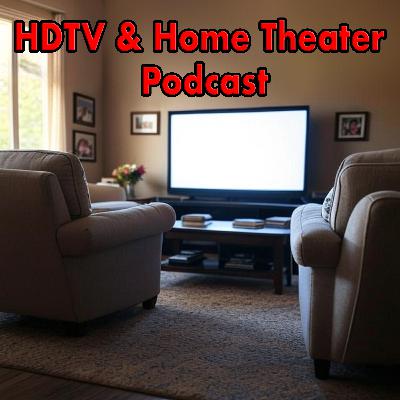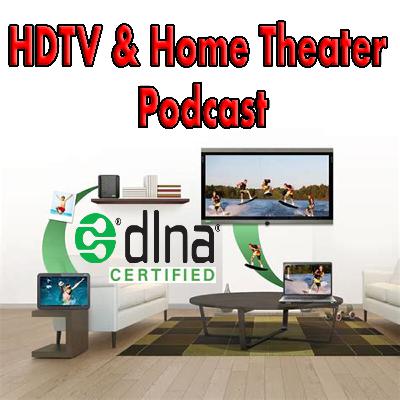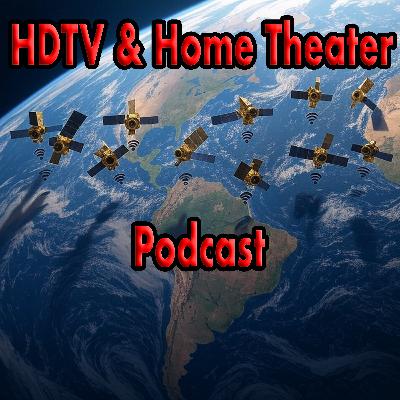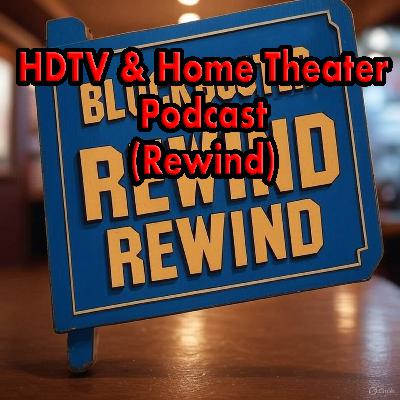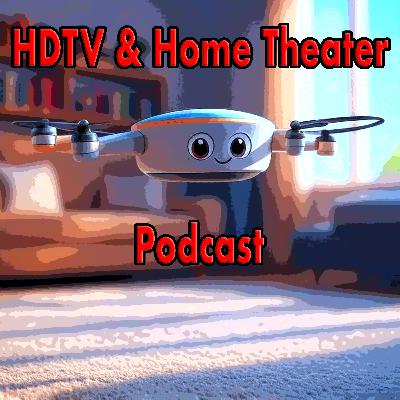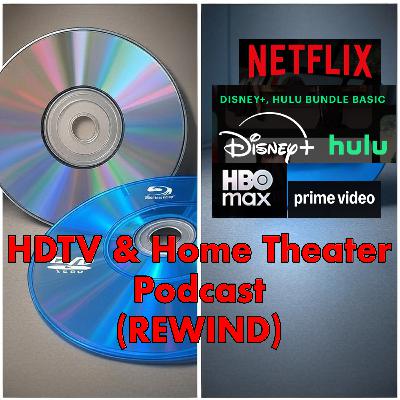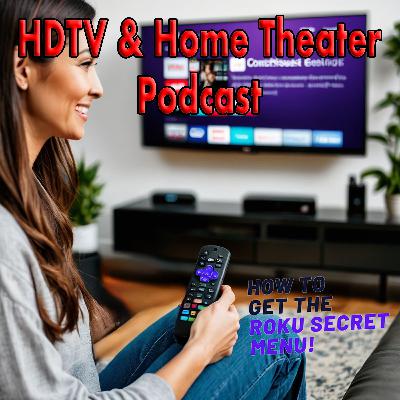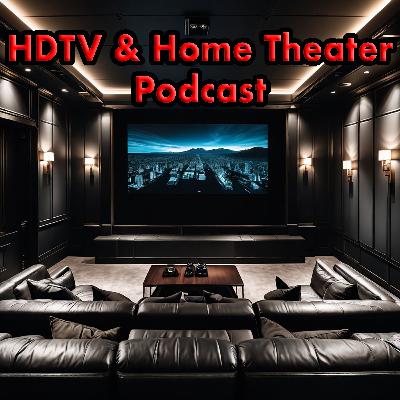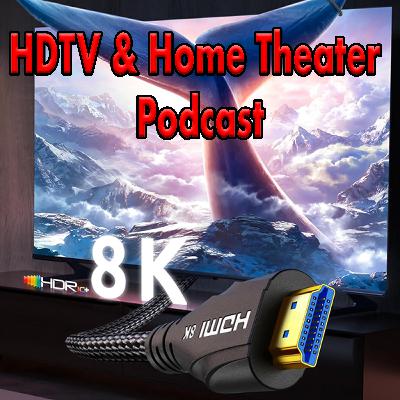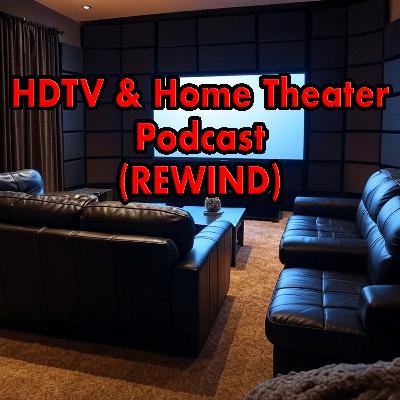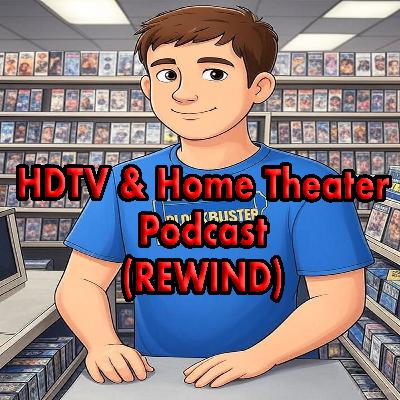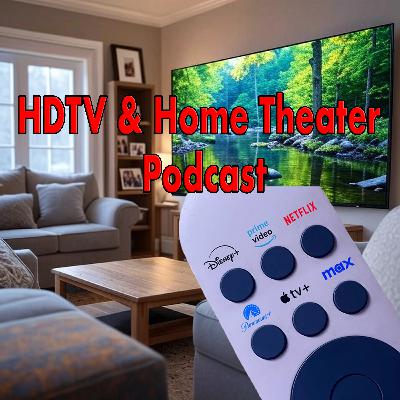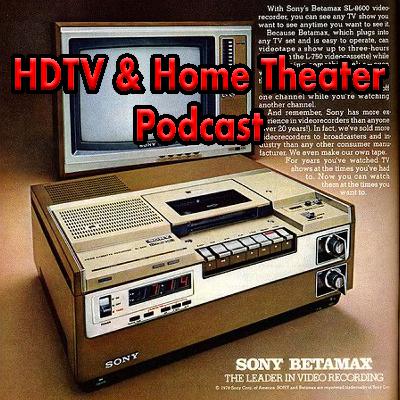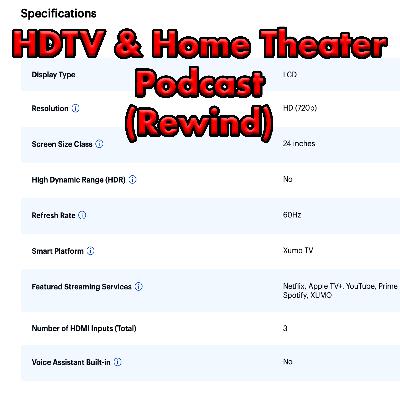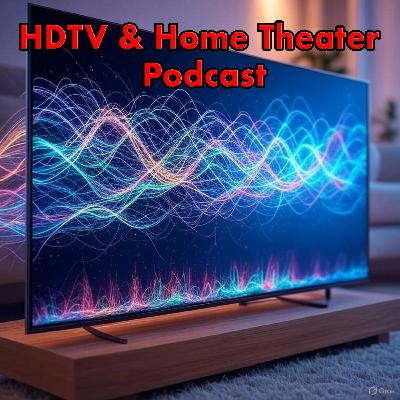Discover HDTV and Home Theater Podcast
HDTV and Home Theater Podcast

HDTV and Home Theater Podcast
Author: HT Guys
Subscribed: 917Played: 23,287Subscribe
Share
Copyright © 2025, HT Guys. All rights reserved.
Description
The HT Guys, Ara Derderian and Braden Russell, are Engineers who formerly worked for the Advanced Digital Systems Group (ADSG) of Sony Pictures Entertainment. ADSG was the R&D unit of the sound department producing products for movie theaters and movie studios. Two of the products they worked on include the DCP-1000 and DADR-5000. The DCP is a digital cinema processor used in movie theaters around the world. The DADR-5000 is a disk-based audio dubber used on Hollywood sound stages. ADSG was awarded a Technical Academy Award by the Academy of Motion Picture Arts and Sciences in 2000 for the development of the DADR-5000. Ara holds three patents for his development work in Digital Cinema and Digital Audio Recording. Every week they put together a podcast about High Definition TV and Home Theater. Each episode brings news from the A/V world, helpful product reviews and insights and help in demystifying and simplifying HDTV and home theater. Our email address is hdtvpodcast@mac.com
784 Episodes
Reverse
On this week’s show we take some time off but still give you a great show. In addition to reading your emails and the news, we do a post mortem on the DVR. News: Netflix unveils the future of streaming with a massive new approach Dolby Vision 2 Is Coming Netflix launches new feature letting customers clip top scenes Other: Bendable Screens TV Tracker: Renewed and Canceled Shows The DVR is Dead We did a show back in 2009 where we highlighted an article that discussed the end of the DVR era. We added our thoughts on the subject and I did an analysis of what it would cost to just buy the shows I watched vs recording them on the DVR. Streaming services were just coming on the scene and we had no idea what was coming down the road. In this episode I go back and discuss what we said back then and how it actually turned out. As always thanks for listening to and supporting our podcast.
On this week’s show we look at an article from What Hi-Fi titled “I just tested one of 2025's best small OLEDs – and it proves most companies are focusing on the wrong thing”. And that thing is brightness. We look at what would make a perfect TV. We also read your emails and take a look at the week’s news. News: Major TV streaming service abruptly hikes prices 33% Everything you need to know about new ESPN streamer You Don't Actually Own That Movie You Just “Bought.” Brightness Isn't Everything We saw an article over at What Hi-Fi titled “I just tested one of 2025's best small OLEDs – and it proves most companies are focusing on the wrong thing” and thought there is a lot of truth to what the author is saying. So today will expand on this article with the HT Guys take. The author argues that TV manufacturers like LG, Samsung, and Sony focus too much on making OLED TVs brighter to compete with Mini LED sets. After testing 2025’s top small OLED TVs, he believes brightness isn’t the key to a great viewing experience. Instead, authenticity, color accuracy, and balanced performance are more important for delivering a cinematic experience true to the director’s vision. Here are six takeaways from the article: The Brightness Obsession: A Misguided Priority? The What Hi-Fi? article criticizes the TV industry's focus on maximizing brightness, which can harm picture quality. In tests comparing 48-inch OLEDs (LG C5, Samsung S90F, Panasonic Z90B), brighter screens often lost subtle details and immersion. For instance, in Dune: Part Two's desert scene, an overly bright TV turned nuanced red and orange dune shades into stark white, flattening the image. OLED TVs were historically dimmer than LED TVs, but new tech like Micro Lens Array and QD-OLED has boosted their brightness to 2000-3000 nits, closing the gap. However, the focus on brightness often overshadows OLED’s strengths—precise light control, deep blacks, and vibrant colors. The What Hi-Fi? review notes that manufacturers prioritize specs over overall picture quality, while the Panasonic Z90B shows a better balance. The Panasonic Z90B: A Lesson in Balance The 48-inch Panasonic Z90B excels in cinematic authenticity, prioritizing accurate colors and contrast over exaggerated brightness. In Civil War, it delivers precise highlights in dark scenes, and in Oppenheimer, it maintains natural skin tones and subtle details in low light, outperforming competitors that lose color depth. Panasonic’s approach aligns with what serious movie fans crave: a picture that immerses you in the story, not one that distracts with exaggerated brightness. The Z90B’s ability to retain detail in both bright and dark scenes, like the sparkling desert dunes or the intricate chandelier in a White House scene, shows that controlled brightness—used only where needed—creates a more three-dimensional, authentic image. This echoes sentiments from TechRadar, which praises Panasonic’s focus on “filmmaker-approved” accuracy over flashy specs, a philosophy rooted in the brand’s collaboration with Hollywood colorists to tune its TVs for true-to-life visuals. The Small OLED Advantage: Why Size Matters Small OLEDs, like the 48-inch models tested, are often overlooked in a market obsessed with supersized screens. Yet, as What Hi-Fi? notes, these TVs are “severely underrated” for their versatility. They’re ideal for space-constrained homes, secondary rooms like bedrooms, or even as high-end gaming monitors thanks to their dense pixel structure, which delivers sharper images. The LG C5, for instance, boasts four HDMI 2.1 ports supporting 4K/144Hz gaming, making it a powerhouse for both movies and interactive entertainment. However, small OLEDs face unique challenges. Their denser pixel layouts generate more heat, which can limit brightness and risk burn-in if not managed properly. What Hi-Fi? suggests that adding heatsinks, as seen in some larger models, could unlock more brightness headroom for 42- and 48-inch sets without sacrificing quality. This could make small OLEDs even more competitive, offering flagship-level performance in compact packages. The Audio Achilles’ Heel One glaring flaw across all tested OLEDs—LG C5, Samsung S90F, and even the Z90B—is their underwhelming built-in audio. The LG C5’s 2.2-channel 40W speakers sounded flat and centralized, while the Samsung S90F’s 2.1.2 60W system lacked power, allowing testers to hold conversations at max volume. What Hi-Fi? is blunt: for a true home cinema experience, a separate soundsystem is non-negotiable. We have been saying this for a number of years now, TVs, especially smaller ones, prioritize aesthetics over speaker space. What Manufacturers Should Learn The author tested 2025 OLED TVs and found that brightness isn't everything. LG and Samsung make great TVs like the C5 and S90F, but Panasonic's Z90B stands out by using brightness carefully to improve contrast and depth. Panasonic's Z95B flagship prioritizes performance over a super-slim design, a choice the author supports. Afterall, a three-inch-thick TV is still about 90% thinner than our first rear projection HDTVs of the same screen size. What Hi-Fi? emphasizes that 48-inch models like the Z90B and C5 are “Goldilocks” options—cinematic yet practical for most homes. Manufacturers should invest in optimizing these sizes, incorporating technologies like heatsinks to boost performance and addressing audio shortcomings with better built-in solutions or seamless soundbar integration. The Future of OLED: A Balanced Approach Looking ahead, the TV landscape is evolving. Emerging technologies like PHOLED and “true” QLED promise even brighter, more vibrant displays without the burn-in risks of traditional OLEDs. But brightness alone won’t win over cinephiles. The future of TVs lies in balancing these advancements with authenticity, ensuring that MicroLED or next-gen OLED panels prioritize cinematic immersion over raw specs. For now, the Panasonic Z90B sets a high bar. Its “as the director intended” philosophy proves that a TV doesn’t need to be the brightest to be the best. If manufacturers shift their focus to color accuracy, controlled contrast, and practical features like better audio and small-screen optimization, they’ll deliver what viewers truly want: a window into the filmmaker’s vision, not a spotlight that blinds it.
On this week’s show ask the question: “What Happened to DLNA Technology” We also read your emails and the week’s news. Also, say hi to Evelyne, our virtual news reader. News: Plex warns users to update systems immediately after detecting worrying security issue Samsung’s $30K Micro RGB TV Is Here Sling TV launches single day, weekend, week-long pass options Apple’s new ‘Charismatic’ smart home OS is getting set to take on Alexa and Google What Happened to DLNA Technology? DLNA (Digital Living Network Alliance) technology, once a popular standard for sharing media like photos, videos, and music between devices on a home network, has largely faded from prominence. Here's a concise overview of what happened: Peak Popularity (2000s–Early 2010s): DLNA, introduced in 2003, enabled seamless media streaming between certified devices like TVs, computers, smartphones, and gaming consoles. It was widely adopted by manufacturers (e.g., Sony, Samsung, LG) and supported by software like Windows Media Player. By 2010, millions of devices were DLNA-certified, with a focus on interoperability and ease of use. Decline in Relevance: Rise of Proprietary Ecosystems: By the mid-2010s, companies like Apple (AirPlay), Google (Chromecast), and Amazon (Fire devices) pushed proprietary streaming protocols that integrated tightly with their ecosystems, offering smoother user experiences and cloud-based features DLNA lacked. Complexity and Inconsistency: DLNA's interoperability was hampered by inconsistent implementation across devices. Some devices supported only specific file formats or had clunky interfaces, frustrating users. Shift to Cloud and Apps: The rise of streaming services like Netflix, Spotify, and YouTube shifted media consumption to app-based, cloud-driven platforms. DLNA's focus on local network sharing became less relevant as users prioritized internet-based content. Emerging Standards: Technologies like Miracast, Wi-Fi Direct, and Bluetooth offered simpler or more versatile alternatives for device-to-device connectivity, further eroding DLNA's niche. DLNA's End (2017): The DLNA organization officially dissolved in 2017, ending certification and development. While some devices and software (e.g., Plex, VLC) still support DLNA for backward compatibility, it’s no longer a focal point for manufacturers or consumers. Current Status: DLNA remains functional on older devices, but it’s largely been supplanted by modern protocols and platforms. For example, smart TVs now rely on app ecosystems or protocols like Google Cast. Some enthusiasts still use DLNA for local media servers, but it’s a niche use case. From our archives (June 2012) What's missing? So if you've tried any of the DLNA servers out there, you've probably seen how bare they are. With so many consumer electronics devices supporting DLNA playback, it seems a really good DLNA server would sell like hotcakes. Here's what we think the perfect DLNA server would do. Support Transcoding. Some DLNA Servers support transcoding, but not all of them. Transcoding allows the server to change the format of the video your watching or song you're listening to to something that the player can actually play back. Otherwise you'll get a bunch of failures trying to play back stuff like DivX and Xvid. Support Cover Art. Most DLNA servers will just grab a video frame out of a movie file and display it as a thumbnail. Why not replace that with the actual cover of the movie? They're easy to find online. It might take a little more setup up front to get all the covers downloaded and in the right place, but it would be worth it. Categorize videos. A few of the servers support a limited amount of categorization for video files, but what you'd really like to do is tag a movie with a genre, a year, rating, actors, director, producer, etc. and use any of those pieces of information to find the right movie. Built-in DVD backup. Consumers want a way to backup their movies. DVDs don't last forever. Allow a user to create a backup copy of their DVD on a hard drive. Of course they'll also be able to watch it from any network connected DLNA player, but that's just a slight benefit of the nifty backup feature. Of course, if you could then provide the built-in... Connection to IMDB. Allow users to automatically populate cover art and meta data info by selecting the correct movie from an online database like IMDB. This would greatly simplify the chore of adding movies to a video library. While this tends to be a one-time event (once per movie at least), it can be painful and tends to wear on you after a while. Support online sources. Right now PlayOn is the only server we've found that supports online video sources. It, however, doesn't support local sources. It looks like that functionality will be coming soon, but the two ideas need to merge for a really great product.
On this week’s show we take a look at the pros and cons of Low Earth Orbiting Satellites and ask if competition from them could lower your Internet bills. One of our listeners does a good analysis of what it would cost cordcutters to watch every NFL and most College football games. We also read your emails and take a look at the week’s news. News: Hulu App to Be Phased Out as Disney Is ‘Fully Integrating’ Service Into Disney+ Fubo drops 100,000 subscribers in Q2 HBO Max to enforce password-sharing crackdown in Sept. Fubo readying sports-only plan for 2025 season Amazon Launches 24 Satellites Aboard SpaceX Rocket to Build Its Home Internet Service Other: dbx 510 Subharmonic Synthesizer for Creating Amazing Deep Bass in Your Home Theater LEO (Low Earth Orbit) Satellite Internet On a recent show we talked about High Speed internet eliminating the need for over the air broadcasting. However we understand that not everyone has access to high speed internet. We mentioned Low Earth Obiting (LEO) satellites as an option. With the news that Amazon has begun putting it's network together, we decided to look at the pros and cons of this type of Internet delivery. LEO satellite internet, like Starlink and the upcoming Amazon Project Kuiper, offers several advantages over traditional satellite based internet. Here's a comparison of the benefits: Benefits of LEO-Based Internet Lower Latency: LEO satellites orbit at 200-2,000 km, much closer than geostationary satellites (35,786 km). This reduces round-trip data travel time, resulting in latency of 20-50 ms compared to 600+ ms for geostationary systems. Benefit: Faster response times for gaming, video calls, and real-time applications, closer to terrestrial fiber (10-30 ms). Global Coverage: LEO constellations, with thousands of satellites, provide internet to remote and rural areas where terrestrial infrastructure (fiber, DSL) is unavailable or costly to deploy. Benefit: Connects underserved regions, ships, planes, and isolated locations. Higher Speeds: LEO systems can deliver download speeds of 100-400 Mbps (with potential for more as technology improves) and upload speeds of 10-40 Mbps, rivaling or exceeding many terrestrial broadband connections. Benefit: Supports streaming, large downloads, and multiple users simultaneously. Scalability: LEO constellations can add more satellites to increase capacity and coverage, adapting to demand more flexibly than laying new cables or building cell towers. Benefit: Easier to expand and improve network performance over time. Resilience: Distributed satellite networks are less vulnerable to single points of failure (e.g., damaged cables or local outages) compared to terrestrial infrastructure. Benefit: More reliable in disaster-prone areas or during natural events. Portability: LEO user terminals (e.g., Starlink dishes) are compact and can be set up anywhere with a clear sky view, enabling mobile or temporary use. Benefit: Ideal for travelers, RVs, or temporary sites like construction zones. Limitations of LEO Internet Compared to Traditional Internet: Cost: LEO internet often requires expensive user equipment (e.g., $300-$600 for a Starlink dish) and monthly subscriptions ($50-$150, depending on region/plan). Traditional internet typically has lower upfront costs (e.g., modem/router) and competitive pricing in urban areas. Weather Sensitivity: LEO signals can be affected by heavy rain, snow, or dense cloud cover, though less severely than geostationary systems. Traditional fiber or cable is generally immune to weather-related disruptions. Network Congestion: In high-density areas, LEO systems may experience reduced speeds if too many users connect to the same satellite or ground station. Traditional broadband, especially fiber, often handles high user density better in urban settings. Line-of-Sight Requirement: LEO terminals need a clear view of the sky, which can be challenging in dense urban areas or locations with tall trees/buildings. Traditional internet (e.g., cable, fiber) doesn’t require line-of-sight. Data Caps and Throttling: Some LEO providers impose data caps or throttle speeds during peak usage, whereas many traditional ISPs offer unlimited plans in urban areas. Benefit to traditional: More predictable performance for heavy users. Summary LEO-based internet excels in global reach, low latency, and flexibility, making it a game-changer for remote areas, mobility, and disaster resilience. However, traditional internet (fiber, cable, DSL) often provides lower costs, higher reliability, and better performance in urban areas with established infrastructure. The choice depends on location, use case, and budget, at least for now.
On this episode of the Rewind show we go back to August 13 2010 where we read your emails, look at a news story or two, discuss DVRs and the Netflix/Epix deal.
On this episode of the Rewind show we go back to August 13 2010 where we read your emails, look at a news story or two, discuss DVRs and the Netflix/Epix deal.
On this week’s show we discuss the 2025 Value Electronics TV Shootout. We also read your emails and take a look at the week’s news. News: Nielsen: Ad-supported content dominates TV viewing NFL sells NFL Media, including RedZone, to ESPN New Fox One streaming service to launch in August Other: How to Increase Storage on Google Chromecast With Google TV Howdy Subscription | Ad-Free Streaming | The Roku Channel Sony Crowned King of TVs for the Seventh Year Running at the 2025 Value Electronics TV Shootout For the seventh consecutive year, Sony has claimed the title of “King of TVs” at the 2025 Value Electronics TV Shootout, held at their Scarsdale, New York showroom. The winning model, the Sony Bravia 8 II OLED (K65XR80M2) $3000, emerged victorious in a fiercely competitive field of flagship OLED TVs from LG, Samsung, and Panasonic. This annual event, now in its 21st year, is a benchmark for videophiles, retailers, and manufacturers, offering a no-nonsense, side-by-side comparison of the best TVs on the market. The Value Electronics TV Shootout Founded in 2004 by Robert and Wendy Zohn, the Value Electronics TV Shootout has become well known for its rigorous and objective evaluation process. Each TV in the shootout is professionally calibrated and tested under identical conditions—same lighting, same content, and against professional-grade Sony BVM-HX3110 mastering monitors, which are the gold standard for video professionals. The TVs are judged on picture quality attributes like color accuracy, contrast, motion handling, and performance in both Standard Dynamic Range (SDR) and High Dynamic Range (HDR). This year’s competition was exclusively dedicated to OLED TVs, with no separate category for LCDs, reflecting the industry’s shift toward OLED’s superior black levels and color reproduction. The 2025 lineup featured four flagship 65-inch OLED models: Sony Bravia 8 II QD-OLED (K65XR80M2) $3000 Samsung S95F QD-OLED (QN65S95F) $3300 Panasonic Z95B WOLED (TV65Z95BP) $2000 US Model is Z95A LG G5 WOLED (OLED65G5WUA) $2900 A panel of ISF-certified judges, including display and film production professionals, evaluated the TVs using a mix of Blu-ray movie clips and specialized test patterns, ensuring a comprehensive assessment of their capabilities. Sony’s Bravia 8 II QD-OLED won top honors for its exceptional SDR performance and consistency. Judges noted Sony’s superior video processing, which delivered cleaner images and better upscaling than competitors. Kevin Miller, ISFTV president and display consultant, stated, “Sony’s video processing is cleaner and handles upscaling better than Samsung’s, despite both using the same quantum dot OLED panel.” This processing edge proved decisive. Panasonic’s Z95B OLED marked its U.S. market return at the 2025 Shootout, narrowly winning the HDR category over Samsung’s S95F by 0.01 points. Absent from the U.S. for years, Panasonic leveraged the event to showcase its OLED lineup, previously limited to Europe and Asia. Alex Fried, Panasonic’s director of business development, emphasized the brand’s renowned picture quality, saying, “It was great to be back in the shootout, reflecting Panasonic’s legacy of top-tier performance.” Samsung’s S95F QD-OLED came in a close second overall, splitting HDR category wins with Panasonic and performing strongly across the board. Its quantum dot OLED panel, shared with Sony, delivered impressive brightness and color volume, but it fell slightly short in SDR due to Sony’s superior processing. LG’s G5 WOLED, however, was a surprising disappointment, finishing last in both SDR and HDR categories. Despite LG’s pioneering role in OLED technology and its use of RGB OLED panels from LG Display, the G5 struggled with color accuracy and EOTF (electro-optical transfer function) issues. Judge Chris Boylan, co-founder of Big Picture Big Sound, noted, “The LG was a little disappointing with some processing issues that lowered its overall scores in some categories. Some of these might actually be fixable with future software updates.” This outcome raised questions about LG’s current standing in the OLED race, especially given its historical dominance in the category. Final Thoughts Sony’s seventh straight “King of TVs” win at the 2025 Value Electronics TV Shootout reaffirms its position as a leader in premium display technology, driven by superior video processing and consistent performance. However, the tight competition—especially Panasonic’s HDR upset and Samsung’s close second—shows that the gap between top-tier OLEDs is narrower than ever. For consumers, this means more choices and exceptional quality across the board. Whether you’re a videophile chasing the ultimate picture or a casual viewer seeking a top-tier TV, the 2025 Shootout proves that OLED is the technology to beat, and Sony’s Bravia 8 II is currently leading the pack. Note - Hisense and TCL were invited to the 2025 Value Electronics TV Shootout but chose not to participate.
On this week’s show we ask what ever happened to the Ring Indoor Security Drone and we take a look at the Top Ten Streaming shows for the first half of 2025. We also read your emails and take a look at the week’s news. News: DirecTV tests convenient new feature for streaming customers Google Home speaker debacle worsens with more failures Social platforms and streamers battle for the living room What Ever Happened to the Ring Indoor Security Drone? I was thinking about all the cool stuff that had been introduced at CES over the years and remembered one that I really wanted to use, the Ring Indoor Security Drone. It's perfect for those who own a home and may want to check in on parts of it without placing cameras everywhere. So what happened to it? Amazon's Ring Always Home Cam, a $249.99 indoor security drone announced in 2020, remains unreleased with no confirmed launch date. Initially planned for 2021 and showcased at CES 2023, it was part of an invite-only U.S. program, now discontinued. Ring’s CEO confirmed ongoing development in 2024, citing challenges with mirrors, windows, and cost. Privacy concerns, technical limitations like a five-minute flight time and inability to navigate stairs, and user frustration on forums suggest delays. A July 2025 report hints at a possible limited release, but Ring’s focus seems to have shifted to AI features and other products. Top 10 Streaming Shows of the First Half of 2025 The first half of 2025 has delivered an exciting lineup of streaming shows that have captivated audiences across platforms. From gritty dramas to thrilling action series, here’s a breakdown of the top 10 streaming shows that dominated screens, as highlighted by The Streamable. Landman S1 (Paramount+) 14.44B min watched: A gritty drama following an oil field worker navigating the high-stakes world of the Texas oil boom. 1923 S2 (Paramount+) 13.29B min watched: The Dutton family faces new challenges in the early 20th century as they fight to protect their Montana ranch during turbulent times. The Night Agent S2 (Netflix) 8.66B min watched: FBI agent Peter Sutherland dives deeper into a web of conspiracies, balancing loyalty and danger in a high-octane thriller. MobLand S1 (Paramount+) 8.04B min watched: A crime drama exploring the gritty underworld of organized crime in a small, corrupt town. Love Island USA S7 (Peacock) 8.01B min watched: A group of singles navigate romance, drama, and challenges in a tropical villa to find love and win a cash prize. Ginny & Georgia S3 (Netflix) 6.32B min watched: The mother-daughter duo faces new secrets and struggles as they adjust to life in a small town with a dark past. The Pitt S1 (HBO Max) 6.24B min watched: A high-intensity medical drama set in a Pittsburgh hospital, focusing on the personal and professional lives of its staff. The Residence S1 (Netflix) 6.06B min watched: A comedic murder-mystery centered on a quirky staff navigating scandals and secrets in the White House. Zero Day S1 (Netflix) 5.97B min watched: A tense political thriller about a cyberattack that triggers global chaos, led by a retired operative seeking answers. Reacher S3 (Prime Video 5.96B min watched): Jack Reacher tackles a new conspiracy, using his brute strength and sharp mind to unravel a dangerous mystery. Netflix led with four titles, while Paramount+ had three. The Streamable notes that HBO’s The Last of Us and The White Lotus would have made the list if non-originals were included. The data underscores the competitive streaming landscape, with platforms like Paramount+ and Apple TV+ gaining ground against Netflix
On this week’s show we take a look at why people are not upgrading their set top boxes and we read your emails and take a look at the week’s news. News: Samsung Develops Cheaper Method Of QLED Panel Production Netflix puts more ads on originals than licensed titles Vizio TVs will now be sold exclusively at Walmart Classic Looney Tunes Cartoons Will Move to Tubi After Leaving HBO Max Why Are Consumers Skipping New Streaming Devices We are big fans of streaming devices for a bunch of reasons like; they have the latest hardware so streamers can take advantage and give you higher quality. Or apps are updated more frequently, Or even that you can have identical experience across different manufacturers. Regardless of why we love them, a recent report by Cord Cutters News, said that devices like Roku, Amazon’s Fire TV, Apple TV, and Google TV aren’t flying off the shelves this year. So, what’s behind this? Why Skip the Upgrade? Well it may be that your 2022 Fire TV Stick is still streaming “Stranger Things” in glorious 4K, or maybe that your Roku Smart TV hasn’t missed a beat with the latest Disney+ releases. According to Cord Cutters News, the majority of Americans are saying, “Why fix what ain’t broke?” The survey reveals that many are perfectly happy with their current streaming devices, which continue to deliver Netflix, Hulu, and more without a hitch. There is also an opportunity cost that spending $50–$150 streaming gadget means they may have to give up a streaming service. “Consumers are realizing last year’s Roku or Fire Stick still streams 4K just fine. Unless there’s a major leap in features, there’s little incentive to upgrade.” So, if your device is still slinging episodes of “The Bear” without buffering, why shell out for a new one? What’s Holding People Back? Device Longevity: Unlike some consumer electronics, which seem to demand upgrades every couple of years, streaming devices are built to last. Companies like Roku, Amazon, and Apple push regular software updates, keeping older models compatible with new apps and features. For example, a 2019 Roku Smart TV can still handle the latest streaming services like a champ. Market Saturation: The numbers don’t lie. Over 80% of U.S. households already own a smart TV or streaming media player, according to 2024 stats from Statista. For many, it’s not about “needing” a new device—it’s about whether they want the hassle of setting up another one. If your living room is already equipped with a streaming stick or smart TV, adding another gadget might feel like overkill. Cost vs. Benefit: For some setting up a new streaming device means re-entering Wi-Fi passwords, logging into apps, and maybe even dealing with a new remote. For most folks, the minor perks of a newer model (slightly faster processor? Shinier interface?) don’t justify the cost or effort. What’s Next for Streaming Devices? If Americans aren’t rushing to buy new streaming devices, what’s the game plan for companies like Roku, Amazon, Apple, and Google? They’ll need to get creative to get us to upgrade. Here are a few possibilities: Software Innovations: Expect a bigger focus on user interfaces, Better more relevant content recommendations, or even augmented reality for interactive viewing. Bundling Deals: To entice satisfied users, companies might offer sweeteners like a free Fire TV Stick with a new smart TV or a discounted Apple TV+ subscription with a new device. Exclusive Content: “Roku and Amazon are likely to double down on exclusive content or partnerships to make their devices more appealing, even to satisfied users.” It’s all about giving us a reason to upgrade when we’re already content. Takeaways So, what’s the bottom line? If you’re one of the many Americans skipping the streaming device upgrade in 2025, you’re in good company. Your current Roku, Fire TV, or Apple TV is likely still performing well, thanks to solid hardware and regular updates. But keep an eye out for deals or game-changing features—like faster processors, better voice controls, or exclusive content—that might make an upgrade worth it.
On this episode of the Rewind show we go back to July 23rd 2010 where we read your emails, look at a news story or two, discuss how to pick an AV Receiver and why Bluray was not selling like hotcakes.
On this week’s show we look at what the posters at AVS forum have spent on their home theaters and we look at the Roku Secret Menu options. We also read your emails and take a look at the week’s news. News: Belkin plans to power down Wemo support in 2026 Netflix Sees Rapid Q2 Subscriber Gains Broadcast TV hits historical viewership low in June Your Roku has secret menus and settings here's how to access them Roku devices have hidden menus for advanced users, offering diagnostic tools, customization options, and more. Full article at ZD Net - Your Roku has secret menus and settings here's how to access them. Here's how to access them using your Roku remote: 1. Developer Settings How to Access: Home × 3 > Up × 2 > Right > Left > Right > Left > Right What It Does: For developers to test apps on Roku. Enables app installation, sideloading, and Roku account management. 2. Network Menu How to Access: Home × 5 > Right > Left > Right > Left > Right What It Does: View IP/MAC addresses, check internet connection, join networks, and toggle bandwidth-saver mode. 3. Wireless Secret Screen How to Access: Home × 5 > Up > Down > Up > Down > Up What It Does: Displays signal strength, antenna info, and error logs. Run AP speed tests or clear Wi-Fi settings. 4. Reset & Update How to Access: Home × 5 > Fast Forward × 3 > Rewind × 2 What It Does: Factory reset, soft reset, search for updates, and USB port tests. 5. Ads & Screenshots How to Access: Home × 5 > Up > Right > Down > Left > Up What It Does: Control scrollable ads, disable screensaver ads, and adjust screenshot output formats. 6. HDMI Secret Screen How to Access: Home × 5 > Down > Left > Up × 3 What It Does: View supported resolutions, refresh rates, HDR settings, switch inputs, and run input tests. 7. Platform Secret Screen How to Access: Home × 5 > Fast Forward > Play/Pause > Rewind > Play/Pause > Fast Forward What It Does: Displays CPU, memory usage, remote diagnostics, IPv6 settings, and remote logs. 8. Channel Info Menu How to Access: Home × 3 > Up × 2 > Left > Right > Left > Right > Left What It Does: View installed channel versions and build numbers. Uninstall apps directly from this screen. 9. Reboot Shortcut How to Access: Home × 5 > Up > Rewind × 2 > Fast Forward × 2 What It Does: Quick reboot without accessing menus. Roku restarts immediately. Tips and Warnings Use these menus cautiously; some actions (e.g., factory reset) are irreversible. Not all menus work on every Roku model (e.g., older devices or specific models like the Roku Smart Soundbar). To exit, press the Home button. For additional settings, explore the standard Settings menu or enable developer mode via Roku’s website for app sideloading. Note: Always back up important settings before experimenting.
On this week’s show we design a high end home theater but one that is within reason because we are not going to spend your money just for the sake of spending money. We also read your emails and the week’s news. News: Max Officially Changes Its Name Back to HBO Max Apple reportedly in pursuit of Formula 1 rights Streaming Subscriptions May Get Tougher to Cancel LG Debuts Wireless OLED Evo M5 Other: PWAYTEK Smart TV LED Backlight with HDMI New Balance - Saturday Night Live Nike Women's Ad - SNL Money is No Object Home Theater - Within Reason We have designed a budget based home theater system before so for this episode we decided to design a money is no object system. This high-end home theater system is centered around an 85" television and a 7.1.2 speaker configuration, optimized for premium performance since budget is not a constraint. We prioritize audio-visual quality, immersive surround sound, and aesthetic integration for a luxurious home theater experience. The room size for this theoretical theater is 15 X 20 feet or approximately 4.5 x 6 Meters. Note that some of these items are listed on our Amazon Influencer Store Front where we make a commission on the sales. Television Samsung QN90D 85" Neo QLED 4K TV This 2025 model offers exceptional brightness (up to 2,000 nits), deep blacks with Mini LED technology, and a 120Hz refresh rate for smooth motion. Quantum HDR 64X enhances color and contrast, ideal for cinematic viewing. Its slim design and anti-glare coating suit various lighting conditions. Price: $2,300 Features: 4K Ultra HD with Quantum Dot technology Dolby Vision and HDR10+ support Built-in smart platform for streaming (Netflix, Disney+, etc.) 4 HDMI 2.1 ports for gaming and external devices Edit - after this week’s announcement by LG we are changing this to the 83 inch LG OLED evo M5 series that costs about $8,750. AV Receiver Marantz Cinema 30 This 11.4 channel receiver delivers 140W per channel, supports Dolby Atmos, DTS:X, and Auro-3D, and handles 8K/60Hz passthrough. Sound Master Tuned & Calibrated For You. Powerful calibration and tuning tools are included, enabling you to get the best performance from your system. Price: $4,475 Features: 11 amplified channels (7.1.2 natively) HDMI eARC for lossless audio Advanced room correction for optimal sound Front Left/Right Speakers: Bowers & Wilkins 702 S3 (Pair) These floor-standing speakers deliver crystal-clear highs and robust mids with 6" midrange drivers and carbon dome tweeters. Their 200W power handling ensures dynamic sound for movies and music. Price: $7,000/pair Center Speaker: Bowers & Wilkins HTM71 S3 From the same family of the 702 S3. For clear dialogue and seamless soundstage integration. Its dual 6.5" woofers and carbon dome tweeter handle complex audio with precision. Price: $2,500 Surround Speakers (4): Bowers & Wilkins 705 S3 (2 pairs) These bookshelf speakers provide immersive surround effects with compact footprints. Their 5" midrange and tweeter design ensures clarity for side and rear channels. Price: $3,000/pair (x2 = $6,000) Height/Atmos Speakers (2): Bowers & Wilkins CCM7.3 S2 In-Ceiling Speakers These in-ceiling speakers are designed for Dolby Atmos, delivering precise overhead effects with a 3-way design (tweeter, midrange, and dual woofers). They blend discreetly into the ceiling for a clean aesthetic. Price: $2,000/pair Subwoofer: SVS SB-5000 This sealed subwoofer delivers deep, controlled bass down to 17Hz with a 2,000W RMS amplifier. Its DSP control and mobile app allow fine-tuning for room acoustics. Price: $2,000 Media Player - So this is where we get in trouble. Logic would say Kaleidescape since money is no object. But our recommendations Ara- Apple TV 4K $250 Braden - Roku Ultra $130 get you all you would need plus you can load your streamers, IPTV services, and automation controls. All with near perfect picture and sound quality. Acoustic Treatments - GIK Acoustics Panels and Bass Traps To optimize sound quality, acoustic panels reduce echo, and bass traps control low-frequency buildup. Custom designs can match room decor. Price: $2,000-$3,000 (depending on room size and coverage) Seating: Salamander Designs Synergy Home Theater Seating (4 seats) Premium leather recliners with motorized adjustments, built-in cup holders, and USB charging. Configurable for tiered rows in a dedicated theater room. Price: $8,000 for 4 seats TV Stand/Mount: Salamander Designs Archetype System Sleek, modular design supports an 85" TV with cable management and space for components. Wall-mount option available for a floating look. Price: $1,500-$2,000 Control System: Here we are going with a Crestron System with installation. These systems can cost as much as $100K for a large home. But for our modest yet high end system we are allocating $10K for the theater area. Cabling and Power: No need for super expensive cables even though money is no object. Afterall, we didn’t make all this money by throwing it away! We are allocating $1000 for monoprice cables and good power conditioners like the Furman Elite-15 PF i Total Estimated Cost: TV: $2,300 or $8,750 for the LG M5 AV Receiver: $4,475 Speakers: $17,500 ($7,000 + $2,500 + $6,000 + $2,000) Subwoofer: $2,000 Media Player: $250 Acoustic Treatments: $2,500 Seating: $8,000 TV Stand/Mount: $1,750 Control System: 10,000 Cabling/Power: $1,000 Total before installation: $49,775 or $56,225 for the LG Total including Installation and calibration of $15,000: $64775 or $71,225 for the LG
On this week’s show we take a first look at the proposed HDMI 2.2 specification. We also read your emails and take a look at the week’s news. News: YouTube Once Again Dominates TV Usage In May SunBrite Debuts Full Sun 4K Smart TV Series XGIMI Releases MoGo 4 Series Projectors Amazon to Shutter Freevee in September 2025, Merging Content into Prime Video HDMI 2.2 Specification The HDMI 2.2 specification, announced by the HDMI Forum at CES 2025, introduces several advanced features to support higher resolutions, refresh rates, and enhanced audio-visual performance. Below is a summary of the key features included in the HDMI 2.2 specification based on the information we have today: Increased Bandwidth (Up to 96 Gbps): HDMI 2.2 doubles the bandwidth of HDMI 2.1 (from 48 Gbps to 96 Gbps), enabling support for higher resolution and refresh rate combinations, as well as data-intensive applications. This increased bandwidth supports uncompressed and compressed video formats, making it suitable for advanced applications like AR/VR, spatial reality, light field displays, medical imaging, and machine vision. Support for Higher Resolutions and Refresh Rates: Uncompressed Formats 4K at 240 Hz and 480 Hz (4:4:4 chroma sampling, 10-bit and 12-bit color). 8K at 60 Hz and 240 Hz (4:4:4 chroma sampling, 8-bit and 10-bit color). 10K at 120 Hz. 12K at 120 Hz. 16K at 60 Hz. Compressed Formats (using Display Stream Compression or similar): Supports higher refresh rates like 4K at 480 Hz, 8K at 240 Hz, and 10K at 120 Hz, which require compression to achieve these rates within the bandwidth constraints. Next-Generation Fixed Rate Link (FRL) Technology: HDMI 2.2 introduces an advanced version of Fixed Rate Link signaling technology, optimized for better support of uncompressed content at high resolutions and refresh rates, ensuring pristine image quality and low latency Ultra96 HDMI Cable: A new cable type, the Ultra96 HDMI Cable, is introduced to support the full 96 Gbps bandwidth and all HDMI 2.2 features. These cables are backward compatible with older HDMI devices but are required to fully utilize HDMI 2.2's capabilities. The Ultra96 cables are part of the HDMI Cable Certification Program, requiring testing and certification with a visible Ultra96 certification label to ensure compliance. Features low electromagnetic interference (EMI) for stable and reliable data transmission. Latency Indication Protocol (LIP): A new feature designed to improve audio and video “‘video synchronization, particularly in multi-hop setups involving devices like AV receivers or soundbars. LIP enhances synchronization over existing methods, reducing issues like lip-sync lag, especially for fast-paced content or gaming. Support for Advanced Color and Chroma Formats: Supports high-quality color spaces like BT.2020 with 10-bit, 12-bit, and 16-bit color depth. Enables uncompressed full chroma formats (e.g., 4:4:4) at high resolutions, ensuring richer colors and pristine image quality. Additional Notes Availability: The HDMI 2.2 specification was announced at CES 2025, with Ultra96 cables expected to be available in Q3/Q4 2025. HDMI 2.2-compliant devices (e.g., TVs, monitors, GPUs) are expected to appear in late 2025 or 2026 Optional Features: Like previous HDMI versions, features such as Variable Refresh Rate (VRR), Auto Low Latency Mode (ALLM), Quick Frame Transport (QFT), and Enhanced Audio Return Channel (eARC) remain optional and depend on device manufacturer implementation. Consumer Guidance: The Ultra96 feature name helps consumers identify cables and devices capable of supporting 64 Gbps, 80 Gbps, or 96 Gbps bandwidth, ensuring optimal performance.
On this episode of the Rewind show we go back to July 2nd 2010 where we read your emails, look at a news story or two, and discuss room acoustic treatments.
On this week’s show we take a look at some of the most popular products in our homes. And we read your emails and take a look at the week's news. News: iOS 26 Brings Video Streaming to CarPlay, But There's a Catch Don’t Expect Netflix to Save U.S. Broadcast Networks HDMI Forum To Reveal New HDMI 2.2 Details At Press Briefing Other: Blockbuster Be Kind Rewind T-shirt - Blue Most Popular HDTV and Home Theater and Automation Products On this week’s show we take a look at some of the most popular products in our homes. Most Popular Devices What is the most popular TV size in the USA The most popular TV size in the USA is currently around 65 inches, with recent trends showing it overtaking the previously dominant 55-inch size. Data from 2021 indicates the average LCD TV screen size in North America reached approximately 55.5 inches, with expectations of further increases as larger TVs become more affordable and accessible. Consumer purchasing trends and retailer insights suggest 65-inch TVs are now the most commonly bought due to their balance of immersive viewing and suitability for typical living room spaces, with viewing distances of around 5.4 to 8.1 feet for 4K resolution. What is the most popular TV brand in the USA Samsung is the most popular TV brand in the USA, holding a market share of around 28-30% based on 2020-2023 data. It has been the top-selling brand for 18 consecutive years, with 30.1% of the market in 2023, driven by brand recognition, diverse price points, and dominance in both standard and premium TV segments, including a 22% share in OLED TVs. LG follows closely, with the two Korean brands combining for about 52% of the market. Vizio, TCL, and Sony also rank highly, with Sony noted for strong consumer trust and picture quality. What is the most popular home cinema projector in the USA The most popular home cinema projector in the USA in 2025, based on expert reviews and consumer interest, is the Epson Home Cinema 3800. It’s widely praised for its excellent balance of image quality, brightness, and value, making it a top choice for home theater enthusiasts. With strong contrast, vibrant colors, and the ability to project a sharp 4K image, it performs well in both dark and moderately lit rooms. Its affordability compared to high-end models like the Epson Home Cinema 5050UB, combined with features like two HDMI ports and easy setup, contributes to its popularity. What is the most popular AVR The most popular AV receiver brand in the USA is Denon, with models like the Denon AVR-X3800H and Denon AVR-X4800H frequently cited as top performers in 2024-2025 reviews. Denon’s popularity stems from its optimal price-to-quality ratio, reliable performance, and advanced features like Dolby Atmos, DTS:X, and 8K HDMI support. Market data is scarce, but Denon’s dominance is evident in consumer reviews, sales rankings on sites like Best Buy, and industry reports, with Marantz (its sister brand) and Yamaha as close competitors. Denon’s models are praised for versatility, supporting setups with more than three speakers (e.g., 9.4 or 7.2.2 configurations), aligning with the 10-15% of households estimated to have such systems. What is the most popular voice assistant product in the USA Amazon's Alexa is the most popular voice assistant product in the USA, primarily due to its widespread integration into Amazon Echo devices and its compatibility with over 60,000 smart home devices. In 2025, Alexa has an estimated 77.6 million users in the US, trailing Google Assistant (92.4 million) and Apple's Siri (87.0 million) in total users but leading in smart home ecosystem adoption and versatility. Its popularity is driven by features like hands-free control, extensive third-party app integration, and the ability to perform tasks such as controlling smart home devices, streaming music, and shopping online. The Amazon Echo (4th Gen) is particularly noted for its sound quality and built-in Zigbee radio, enhancing its smart home capabilities. What is the most popular video doorbell in the USA While exact sales data is unavailable, the Ring Battery Doorbell and Ring Video Doorbell (2nd generation) are likely the most popular video doorbells in the USA in 2025. What is the most popular smart switch in the USA The Lutron Caséta is the most popular for its balance of advanced features, no-neutral-wire flexibility, and rock-solid performance across smart home platforms. Its hub requirement adds cost (around $60-$100 per switch plus $80-$100 for the hub), but users value its dependability and customization options. If you’re on a budget or prefer Wi-Fi-based switches, the TP-Link Kasa models are nearly as popular due to their lower price (around $20-$40) and hub-free setup. What is the most popular smart plug in the USA TP-Link Kasa Smart Wi-Fi Plug Slim (EP25) frequently comes up as a top contender for indoor use due to its affordability, feature set, and wide compatibility.
On this episode of the Rewind show we go back to June 25th 2010 where we read your emails, look at a news story or two, and look at a company called Quartics and what they are up to today.
On this week’s show we rank our favorite Streaming Services. We also read your emails and take a look at the week’s news. News: More than 25% of viewers aren’t watching live TV anymore Tubi breaks the 100 million monthly active user mark Netflix to Introduce Live TV Channels in France NCIS: Tony & Ziva Sets September Premiere Date on Paramount+ Other: Panasonic DVD Recorders on ebay Panasonic DMR-EH75VS DVD recorder with 80GB hard drive and HiFi VCR, plus DVD video upconversion at Crutchfield The 10 Best DVD Recorders of 2025 (Reviews) - FindThisBest "It's Official: Streaming Is Now the King of TV The Definitive Streaming Service Ranking We received an email from a listener named Scott that pointed us to an article titled ”The Definitive Streaming Service Ranking” written by Josh Rosenberg and published in Esquire magazine. In the article he ranks the top seven streaming services. We’ll go through his picks from seven to one. And then we’ll give our rankings. 7 Amazon Prime Video - The main criterion for ranking streaming services is whether they offer at least one new, worthwhile show each month. Prime Video falls short, as it doesn't consistently deliver high-quality new TV content. Instead, it focuses on being a hub for accessing other subscriptions, with shows like Reacher, Fallout, and The Boys feeling like bonuses for Amazon Prime's free shipping rather than a compelling reason to subscribe for streaming alone. 6 Peacock - Peacock is a top choice for reality-TV fans, offering Bravo’s full lineup, including Real Housewives, Love Island USA, Below Deck, Top Chef, and Watch What Happens Live. It also hosts NBC’s library with classics like The Office, Parks & Recreation, New Girl, Scrubs, and Law & Order, plus Yellowstone due to an exclusive deal. Its appeal lies in its sitcom and reality-TV vault, and it’s the streaming home for the Olympics, though that’s only every two years. Fans might find it worth a high price, though it’s currently much less than $100 a month. 5 Disney/Hulu/ESPN+ - The Disney/Hulu/ESPN+ bundle is perceived as a single streaming service due to its long-standing integration, with Disney enhancing this by adding Hulu and ESPN+ tiles to the Disney+ home screen for seamless access. Each service offers unique strengths: Disney+ excels in Marvel, Star Wars, and children’s content; Hulu features FX shows like The Bear and Shōgun, plus ABC’s lineup, including Abbott Elementary; and ESPN+ remains a leader in live sports despite growing competition. Their combined appeal keeps them competitive, as they are stronger together than individually. 4 Netflix - Netflix benefits from long-term subscriber relationships, with users browsing its platform like they once did with cable TV. However, its content quality is declining, with more misses than hits. The upcoming conclusion of major shows like Squid Game and Stranger Things in 2025 could further challenge its ability to retain subscribers. 3 Paramount+ - Paramount+ benefits from Taylor Sheridan's popular shows like Yellowstone, Landman, and 1923, and its merger with Showtime has brought quality series such as MobLand and Yellowjackets. However, the streaming service struggles to justify its subscription cost as essential, with its success hinging on the delivery of Sheridan's planned spin-off universe. 2 Apple TV+ - Apple TV+ has significantly improved its content in 2025, with successful shows like Severance season 2, The Studio (Seth Rogen), Your Friends and Neighbors (Jon Hamm), and Stick (Owen Wilson). Previously, subscribing only for specific shows was advisable, but now, due to consistent high-quality releases with A-list talent, keeping the subscription active is recommended. If this trend continues, Apple TV+ will remain a strong competitor in the streaming market. 1 HBO Max - HBO tops the power ranking due to its consistent delivery of high-quality TV shows that justify the subscription cost. With a business model focused on quality since its launch over 50 years ago, HBO has aired acclaimed series like The Pitt, The White Lotus, The Last of Us, The Rehearsal, and Hacks in the first half of 2025. Its extensive library includes some of the greatest shows and movies, such as Goodfellas. While Netflix prioritizes quantity, HBO Max excels in quality.
Can you believe Betamax turns 50 this month? On this week’s show we look at how the VCR changed the entertainment industry and gave us a reason to build our home theaters. We also read emails and take a look at the week’s news. News: YouTube Is Swallowing TV Whole, and It’s Coming for the Sitcom Roku adds more premium features to its own line of midrange TVs Other: Philips Hue Play HDMI sync box 8K Cosm The Betamax Turns 50 this Month In the late 1970s, the arrival of the Video Cassette Recorder (VCR) sparked a seismic shift in entertainment, as detailed in a recent Hollywood Reporter feature. Initially met with skepticism by studios fearing piracy, the VCR became a cultural juggernaut, reshaping how audiences consumed media and how Hollywood operated. By 1987, home video revenue surpassed theatrical box office earnings, with VHS tapes turning movies like Top Gun into cultural touchstones that families could own and rewatch endlessly. The VCR democratized access to films, birthing the video rental industry—think Blockbuster’s neon-lit aisles—and empowering consumers to curate their viewing experiences. It also gave studios a lucrative new revenue stream, with tapes priced high for rentals before dropping for mass ownership. Yet, the technology wasn’t without flaws: tracking issues, bulky machines, and the dread of “Be Kind, Rewind” defined the era. Beyond movies, the VCR enabled niche content to thrive, from fitness tapes to obscure genres, while fueling Hollywood’s sequel-driven franchises. As The Hollywood Reporter notes, the VCR’s legacy endures in today’s streaming wars, where on-demand viewing owes its roots to those clunky cassettes. The VCR didn’t just change Hollywood—it rewired how we connect with stories. Here are some fun facts about the VCR (Video Cassette Recorder): First Commercial VCR: The Ampex VRX-1000, introduced in 1956, was the first commercially available VCR. It cost around $50,000 (equivalent to over $500,000 today) and was primarily used by TV studios, not homes. Home VCRs Arrived Late: The first consumer VCR, the Philips N1500, hit the market in 1972 in the UK. It was pricey (around £400, or $4,000 today) and could only record for about an hour. Format Wars: The 1970s saw a fierce battle between Sony’s Betamax (1975) and JVC’s VHS (1976). VHS won due to longer recording times (up to 4 hours vs. Betamax’s 1 hour initially) and better marketing, despite Betamax’s slightly superior picture quality. Rental Boom: Video rental stores exploded in the 1980s because VCRs were affordable, but tapes were expensive ($50-$100 each). The first Blockbuster opened in 1985, capitalizing on this trend. Time-Shifting Revolution: VCRs introduced “time-shifting,” letting people record TV shows to watch later. This was groundbreaking, though networks initially feared it would kill live TV. A 1984 U.S. Supreme Court ruling upheld home recording as legal, boosting VCR popularity. Early Adopters’ Struggles: Early VCRs were clunky, with complex controls. The infamous “blinking 12:00” on VCR clocks became a cultural joke because many users couldn’t figure out how to set the time. Global Impact: By 1980, only about 1% of U.S. households had a VCR, but by 1990, over 70% did. Japan led early adoption, with companies like Sony and JVC driving innovation. Peak Sales Period (1977–2000): The VCR was a dominant consumer electronics product for about two decades. We can estimate U.S. sales alone at approximately 100–200 million units over this period. Market Decline: VCR sales peaked in the 1980s and 1990s but declined sharply in the early 2000s as DVDs overtook VHS. By 2003, DVD sales surpassed VCR sales, and the last VCRs were manufactured by Funai in 2016.
On this episode of the Rewind show we go back to June 11th 2010 where we read your emails, look at a news story or two, and look at TV Specifications.
On this week’s show our listeners have provided the topics. We discuss a $30 hack to improve your TV as well as a new OLED technology that may turn your screen into a multi channel speaker. Plus we read your emails and take a look at the week’s news. News: ‘Stranger Things’ Season 5 Gets Three-Part Release, Series Finale Set for New Year’s Eve 66% see YouTube as destination for long-form movies, TV shows Scorsese Doesn’t Go To Cinemas Anymore $30 Dollar Hack to Improve Your TV One of our listeners, Scott, sent us a link to an article suggesting that a $30 LED strip can significantly enhance your TV viewing experience. The full article is titled I stuck this $30 LED strip on the back of my TV. My eyes thank me daily. We’ll summarize here but check out the article for more detail. The author of the PCWorld article shares his positive experience with a $30 USB-powered LED strip, initially inspired by the concept of bias lighting to reduce eye strain by counterbalancing a TV's bright display. After research, the budget-friendly strip proved easy to install, powered directly by the TV, and automatically synced with the device’s on/off function. Installation was simple, involving a clean surface and careful placement of the adhesive-backed strip along the TV’s rear edges, cut to fit for even light distribution. The soft, ambient glow reduced eye fatigue, enhanced contrast and color vibrancy, and made dark scenes in movies and games more enjoyable, proving a cost-effective alternative to pricier lighting systems, and a recommended upgrade for better comfort and visual quality. Turn Your OLED Screen Into a Multi Channel Speaker And another listener, Bob, sent us an article about a technology being developed that could lead to the world's first Pixel-Based Local Sound OLED (PLS-OLED) display. It would allow each pixel to emit different sounds simultaneously, effectively turning the display into a multichannel speaker array. This breakthrough was successfully demonstrated on a 13-inch OLED panel, similar to those used in laptops and tablets. The technology could potentially revolutionize applications in devices like smartphones, tablets, laptops and possibly televisions by combining visual and audio functions in a single, ultra-thin panel. The study was published in Advanced Science in 2025. This is our take on how this technology can be used to enhance a home theater system for some users: Integrated Audio-Visual Experience: Fewer Speakers: With PLS-OLED, the audio comes directly from the screen, eliminating the need for external speakers and creating a cleaner, more streamlined setup. Immersive Sound: Since each pixel can emit distinct sounds, the technology enables precise, localized audio output. This means sound can appear to come directly from the action on screen. A character’s voice would originate from their mouth or an explosion sounding like it’s bursting from the exact spot on the display—enhancing the realism of the home theater experience. Multichannel Audio Without Additional Hardware: Surround Sound Simulation: The multichannel capability of PLS-OLED can mimic surround sound to some degree by directing different audio channels through various parts of the screen. However, we don’t see this replacing a good 7.1 setup, rather it would enhance the audio. Enhanced Aesthetics and Space Efficiency: Reduced Equipment: By integrating high-quality audio into the display, you eliminate the need for a separate audio receiver, subwoofers, and multiple speakers, saving space and reducing setup complexity. Potential for Advanced Applications: Personalized Audio Zones: In a home theater shared by multiple viewers, the pixel-based sound could theoretically create localized audio zones, allowing different people to hear optimized sound based on their seating position, though this might require further development or additional hardware like head-tracking. Possibly delivering a more accurate 3D audio experience directly from the screen. Practical Considerations: Installation Ease: Unlike traditional systems that demand careful speaker placement and calibration, PLS-OLED simplifies setup—just mount the display and connect it to your media source. This is ideal for users who want a plug-and-play home theater solution. Limitations and Next Steps: Sound Power: The article doesn’t specify the volume or frequency range of the audio output. Most of us want deep bass and loud, clear sound, so in reality you would still want a subwoofer for a fuller sound. Conclusion: The Pixel-Based Local Sound OLED technology could revolutionize simple home theaters by combining high-quality visuals and multichannel audio in one device, delivering a more immersive, space-efficient, and aesthetically pleasing experience. It’s particularly promising for compact setups or users seeking simplicity without sacrificing sound quality.
Comments
 United States
United States


